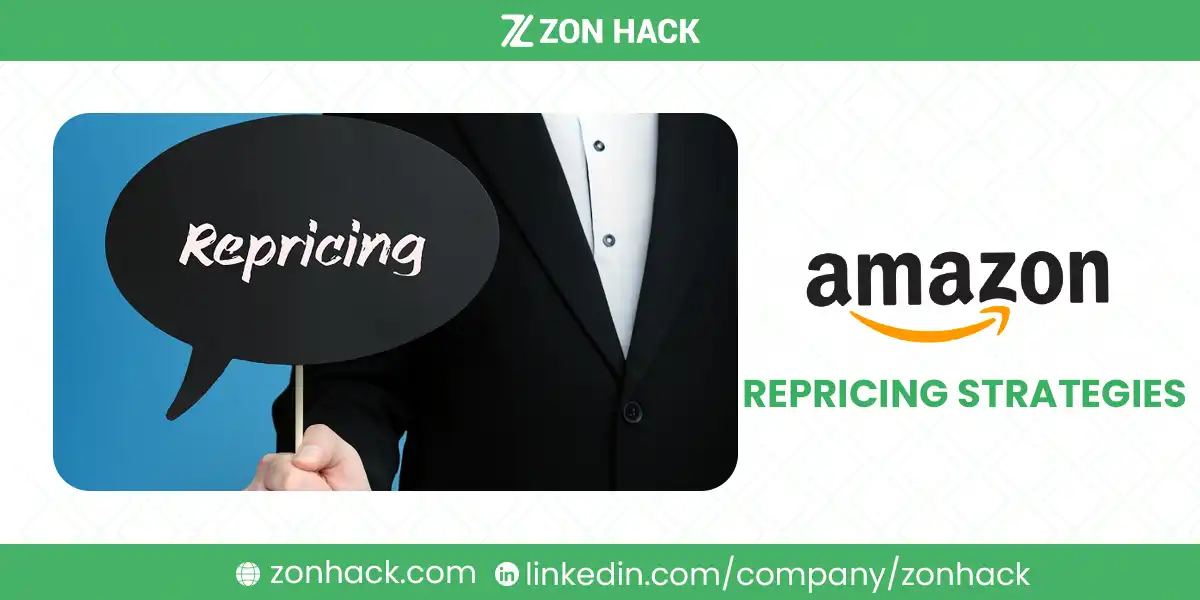Selling on Amazon isn’t just about having a great product. It’s about staying competitive every single minute, especially in a marketplace where price changes happen thousands of times a day. This is where repricing comes in.
Repricing is the method of adjusting your product’s price—either manually or automatically—based on market trends, competitor moves, and your own sales goals. The objective is simple: keep your listings appealing without undercutting your own profits.
At ZonHack, we help Amazon sellers build smart repricing systems. These aren’t generic, off-the-shelf solutions. They’re tailored strategies that consider your margins, your inventory, and your growth targets.
Why Repricing Matters on Amazon
Amazon is, by design, one of the most price-sensitive marketplaces in the world. Over 80% of all Amazon sales happen through the Buy Box, and pricing is one of its core factors.
When buyers view a product with multiple sellers, they often don’t browse all the options. They click “Add to Cart” from the Buy Box, and whoever owns that box gets the sale.
In a market with over 9 million sellers globally, static pricing simply doesn’t work. You need a dynamic strategy that adapts in real time.
With smart repricing, you can:
- Win the Buy Box more often
- Increase sales velocity
- Improve your Best Sellers Rank (BSR)
- Protect or even grow profit margins
Manual vs. Automated Repricing
Manual repricing involves adjusting prices yourself, SKU by SKU. It’s doable for small-scale sellers with under 10 listings, but even then, it’s time-consuming and reactive.
By contrast, automated repricing uses rules or algorithms to change prices based on real-time market conditions. It can be as simple as “match the lowest price minus $0.01” or as complex as machine-learning models adjusting to demand curves, seller ratings, and shipping speeds.
Types of Repricing
Rule-Based Repricing
This type of repricing relies on simple if/then logic. For example: “If a competitor’s FBA price drops below mine, adjust my price to $0.02 less.”
Advantages:
- Easy to set up
- Works for sellers with tight budgets
But there are serious limits. Rule-based systems can’t account for things like:
- A competitor’s slow shipping
- Your superior feedback rating
- Stock availability
In short, they can trigger price wars, sacrificing profits in a race to the bottom.
Algorithmic (AI-Driven) Repricing
AI-based tools consider dozens of variables in real time, far beyond just competitor pricing.
They factor in:
- Buy Box ownership history
- Inventory turnover
- Time-of-day trends
- Competitor stockouts
- Price elasticity
- Fulfillment type (FBA vs. FBM)
- Your seller metrics: ODR (Order Defect Rate), LSR (Late Shipment Rate), Valid Tracking, and more
These tools are ideal for scaling brands doing $50,000+/month in revenue or managing large catalogs.
ZonHack recommends AI repricers such as Aura, BQool, or RepricerExpress, and often builds custom solutions that blend pricing with advertising and inventory forecasting.
Key Benefits of Repricing for Amazon Sellers
1. Winning the Buy Box
About 83% of Amazon sales happen through the Buy Box. This isn’t just a number—it’s the difference between exponential growth and getting buried on page three.
AI repricing tools help you win the Buy Box by analyzing more than just price. They account for:
- Shipping speed
- Stock levels
- Customer ratings
- Response time to customer messages
ZonHack ensures your listings stay eligible and competitive by configuring repricing logic that reacts to these real-time metrics.
2. Boosting Sales and Revenue
Smart repricing drives more visibility and faster sell-through. Sellers often see a 2x to 3x increase in sales when switching to AI repricing.
3. Improving Best Sellers Rank (BSR)
Your BSR is directly tied to sales velocity. The faster you sell, the better your ranking. Better rankings bring more organic traffic.
Effective repricing creates sales momentum, which Amazon’s algorithm rewards.
4. Retaining Customers
Customers appreciate fair pricing that reflects demand and availability. Timely discounts—especially for repeat buyers—can build long-term loyalty.
Value-based repricing (rather than always being the cheapest) helps preserve your brand integrity.
5. Creating Competitive Moats
Repricing alone doesn’t win the war. But repricing combined with faster fulfillment, better customer service, and optimized listings creates an edge your competitors can’t easily copy.
ZonHack helps coordinate all these levers for a defensible growth strategy.
Key Variables in Dynamic Repricing
A good repricer doesn’t just adjust based on price. It analyzes dozens of signals to make intelligent decisions.
ZonHack repricing audits consider 20+ variables, including:
- Fulfillment method (FBA > FBM for Buy Box)
- Landed price (item price + shipping + tax)
- Shipping time (faster shipping boosts Buy Box eligibility)
- Inventory turnover rate
- Order Defect Rate (ODR): Must be under 1%
- Late Shipment Rate (LSR): Should be under 4%
- Valid Tracking Rate: Minimum 95%
- Customer feedback (volume, recency, and rating)
- Seller response time: Ideally under 12 hours
- Competitor stock availability
- Price elasticity of your product category
- Review score of competing listings
- Location (domestic vs. international)
- Seasonal demand or time-based price triggers
We take all these into account when designing a repricing strategy.
Advanced Amazon Repricing Strategies
Buy Box Optimization
Winning the Buy Box isn’t solely about offering the lowest price. It’s about strategically positioning your offer to align with Amazon’s algorithm, which considers factors like shipping speed, seller rating, and fulfillment method.
Key Tactics:
- Dynamic Pricing Adjustments: Monitor competitor stock levels. If a competitor goes out of stock, you can increase your price slightly while still retaining the Buy Box.
- Performance-Based Pricing: Leverage your superior seller metrics (e.g., Order Defect Rate, Late Shipment Rate) to justify higher prices while maintaining Buy Box eligibility.
Cross-Product Pricing (Private Label)
For private label sellers, it’s essential to consider the broader market landscape rather than just identical ASINs.
Strategy:
- Market Benchmarking: Analyze pricing trends across similar products in your category to set a competitive yet profitable price point.
- Value Proposition Emphasis: Highlight unique selling points (e.g., quality, features) to justify premium pricing.
Sales-Based Push Pricing
Adjusting prices based on sales velocity can help maximize profits and manage inventory effectively.
Implementation:
- Incremental Price Increases: After every set number of units sold, slightly increase the price to test the market’s willingness to pay more.
- Price Reductions for Stagnant Sales: If sales slow down, consider reducing the price temporarily to stimulate demand.
Manual Adjustments with Guardrails
While automation is crucial, manual oversight ensures that pricing strategies align with broader business goals.
Best Practices:
- Competitor Analysis: Regularly review competitors’ pricing, shipping times, and customer reviews to make informed adjustments.
- Set Minimum and Maximum Price Thresholds: Establish price floors and ceilings to prevent unprofitable pricing or price gouging.
Pause and Jump Tactic
This advanced strategy involves temporarily pausing the repricer to reset market expectations.
Steps:
- Pause Repricer: Temporarily halt automated pricing to prevent immediate reactions to market changes.
- Increase Price: Manually raise the price to a higher level to test the market’s response.
- Resume Repricer: Reactivate the repricer to adjust prices based on the new market dynamics.
Dynamic ROI Based on Inventory Age
Adjusting pricing strategies based on how long inventory has been in storage can help manage storage costs and cash flow.
Approach:
- New Inventory: Aim for higher ROI by pricing new stock at premium levels.
- Aging Inventory: Gradually reduce prices on older inventory to encourage sales and avoid long-term storage fees.
Strategic Competitor Monitoring
Not all competitors pose the same threat. Focus on those who directly impact your sales.
Focus Areas:
- Fulfillment Method: Prioritize monitoring FBA sellers, as they often have an advantage in winning the Buy Box.
- Seller Ratings: Keep an eye on competitors with similar or higher seller ratings.
- Stock Levels: Monitor competitors’ inventory to anticipate potential stockouts, which can be opportunities to adjust your pricing.
Value-Based Competition
Competing solely on price can erode profits. Emphasize the value your product offers.
Strategies:
- Enhanced Listings: Use high-quality images, detailed descriptions, and bullet points to showcase product benefits.
- Customer Service: Provide exceptional customer support to build trust and encourage repeat purchases.
ZonHack’s Approach to Amazon Repricing
At ZonHack, we understand that effective repricing is not a one-size-fits-all solution. Our approach is tailored to each seller’s unique needs.
Our Process:
- Comprehensive ASIN Audit: We analyze your product catalog to understand price sensitivity and market positioning.
- Customized Repricing Strategy: Based on the audit, we develop a strategy that aligns with your business goals and market dynamics.
- Tool Integration: We integrate and configure the most suitable repricing tools, whether rule-based or AI-driven, to automate pricing decisions.
- Continuous Monitoring and Adjustment: We provide ongoing support to adjust strategies in response to market changes and performance metrics.
Repricing Is a Growth Lever — Use It Strategically
In the competitive landscape of Amazon, smart repricing is essential for success. It’s not about being the cheapest; it’s about being the most strategic. By leveraging advanced repricing strategies and tools, sellers can win the Buy Box, increase sales, and scale their business profitably.




